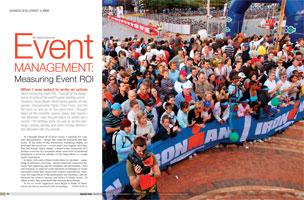
When I was asked to write an article about measuring event ROI, I thought of my experiences at some of the world's great sporting events - Olympics, Super Bowls, World Series games, all-star games, championship fights, Final Fours, and the list went on and on. At the same time, I thought about all the concerts, operas, plays, and movies I had attended. I also thought about my eldest son's recent 11th birthday party, as well as all the weddings, holiday parties, and even Sunday dinners I had attended with my parents.
 |
| Photo © Ankevanwyk - Dreamstime.com |
As I thought about all of these events, I searched for common denominators - things that could be measured and analyzed. In the midst of that brainstorm, something simple, yet profound dawned on me - events aren't just singular activities, they are brands. Quite simply, a brand is the connection of a product or service to a consumer where some level of emotional attachment is involved, whether it's the Super Bowl or a youth sports tournament.
In short,with each of these events there is a product - something of substance occurring - and an emotional connection between that happening and the attendees and participants. First and foremost, in order for event operators or managers to create successful events they must create realistic expectations, maximize the experiences of the participants and attendees, and understand the relative success and failure of those events. In others words, they must build and measure these brands.
To do so, event organizers must begin to think of themselves not just as executors, but as strategic brand managers - professionals who possess the ability to not only conquer the tactical and logistical elements of event execution, but folks who can bring vision and strategic abilities to the table in order to create deeper and more meaningful emotional connections.
However, that isn't as easy as it sounds. Even the best brand builders struggle with the intangible aspects of building a brand. Meanwhile, most laymen can't differentiate between branding and marketing - hence, the first challenge for any brand builder is to truly understand the process.
In brief, there are four essential levels of brand equity from the consumer's perspective:
Awareness - A consumer becomes interested in a brand and is aware of its attributes.
Attraction - The consumer is motivated by features and benefits of the brand, but still doesn't personalize the experience or relationship deeply.
Attachment - The brand becomes personally important to the consumer. He or she cares about the happenings and well being of the brand.
Allegiance - The consumer's thoughts and support become biased in favor of the brand. The brand's competition is minimized and loyalty to the brand by the consumer ranges from solid to exceptional. Brand loyalty is the most important quality - it minimizes expense in maintaining customers.
 |
| Photo courtesy of AL Gulf Coast Sports Commission |
Therefore, analyzing where participants and attendees are within this paradigm becomes the first set of criteria that must be measured by event organizers.
Another key measure relates to how consumers are pushed through the paradigm. In other words, what will help take a consumer on the journey from "awareness" to "allegiance"? The answer is simple: the offering must be fundamentally relevant and different at the same time. "Huh?"
Yes, it can indeed be both. In terms of relevance, the event must be something participants and attendees want - appealing to the essence of why he or she has chosen to attend. However, the elements must be able to be easily differentiated compared to like experiences. In other words, if I attended a baseball game, I would expect to watch good competition, have a comfortable seat, be entertained between innings, eat a hot dog, have a beer, etc. Those things are relevant.
However, in order to truly create differentiation and distinction, the game must be produced at the highest quality, the seat must be the most comfortable I have sat in at a sporting event, the entertainment should be better than I expected, the hot dog should be bigger and tastier than the last hot dog I had, and the beer must be crisper and colder than I can remember having.
Hence, measuring an attendee's level of relevance and differentiation is key as well.
Finally, a great brand builder - one dedicated to information, intelligence and measurement - needs to study the relationship between his or her consumers' attitudes and behaviors. For example, some people chose to attend an event but have no emotional connection to that event. On the other hand, other people may have a huge emotional connection to an event, but can't afford to go.
Therefore, understanding this dynamic is critical to determining the potential ROI of an event. If attendees' and participants' attitudes and behaviors both test high, ROI will be off the charts. If they both test low, don't count on good feelings or a return visit. If behavior was high, but attitude low, then you have a vulnerable constituent. If the converse is true, you have a budding fan - you just have to determine what it will take to increase behavior.
 |
| Photo courtesy of AL Gulf Coast Sports Commission |
Now comes the tricky part. How does a brand building event organizer actually capture the aforementioned data? The answer is not simple, but the need for a solution imperative. Event organizers need to create systems of measurement - with a variety of tools to do such analyses. And not only do such organizers need the tools and methods of measurement, they need to know what to ask.
Let's begin with the tools. Surveys, focus groups and social media are three ways to begin measuring participants' and attendees' experiences and perceptions. Implementing them on a strategic and frequent basis is required to build consistency and statistical significance. Surveys can be the most quantifiable - asking a group of participants and attendees questions that measure the connectivity, satisfaction, attitudes and behaviors can provide incredible insights.
At the same time, regularly hosted and professionally conducted focus groups can provide excellent qualitative information. This data, when tracked over time, can provide an excellent road map for strategic decision-making, especially when combined with more quantifiable survey data.
The newest and least intrusive way to gather event brand data is through social media. Done correctly, social media tools can provide a unique combination of data that is qualitative (people expressing opinions) and quantitative (more relevant as more followers or fans are added) - with information collected in a more casual and less obvious manner.
In the end, if the information is collected well - no matter the means - understanding participants' and attendees' experiences with an event will begin to dictate return on investment. If participants and attendees score high in all areas, an event organizer should keep doing what he or she is doing and give them more of the same. If that is not happening, the measures can help determine what is wrong and how to fix the problem.
Therefore, the return on investment for events can be more easily measured if event operators understand that an event is a brand and thus become strategic brand managers - using traditional and non-traditional brand building and measurement tactics. If done correctly, analyzing the success or failure of an event will be more easily determined as will the return on investment associated with that event.

